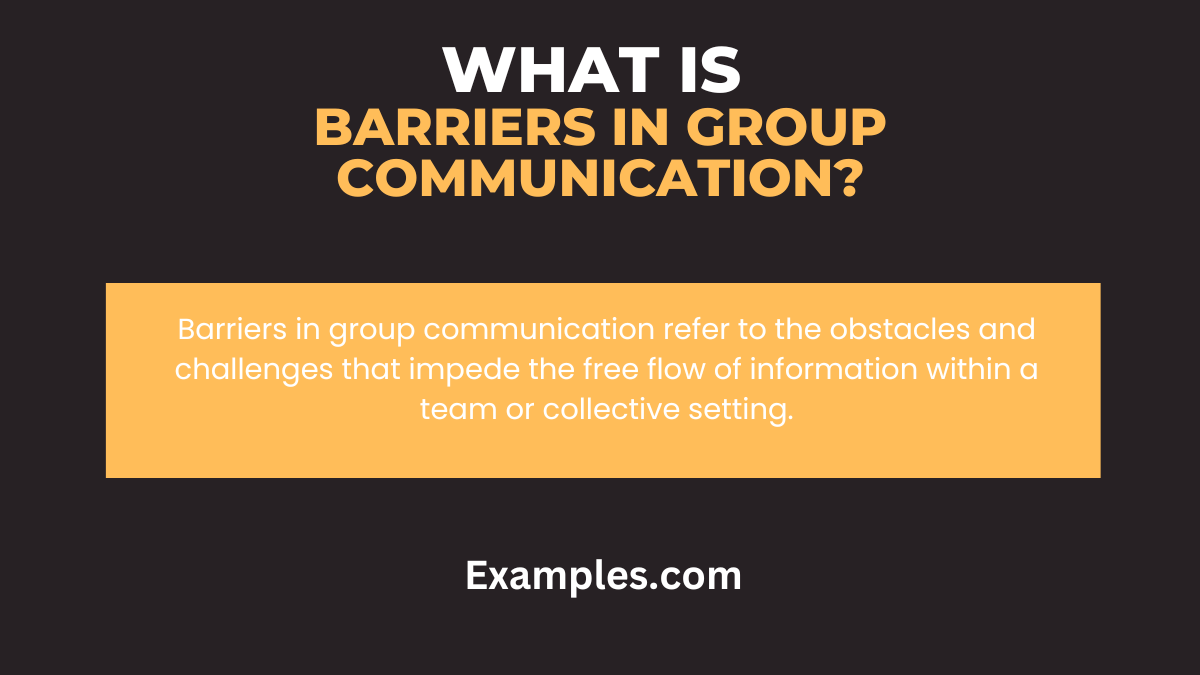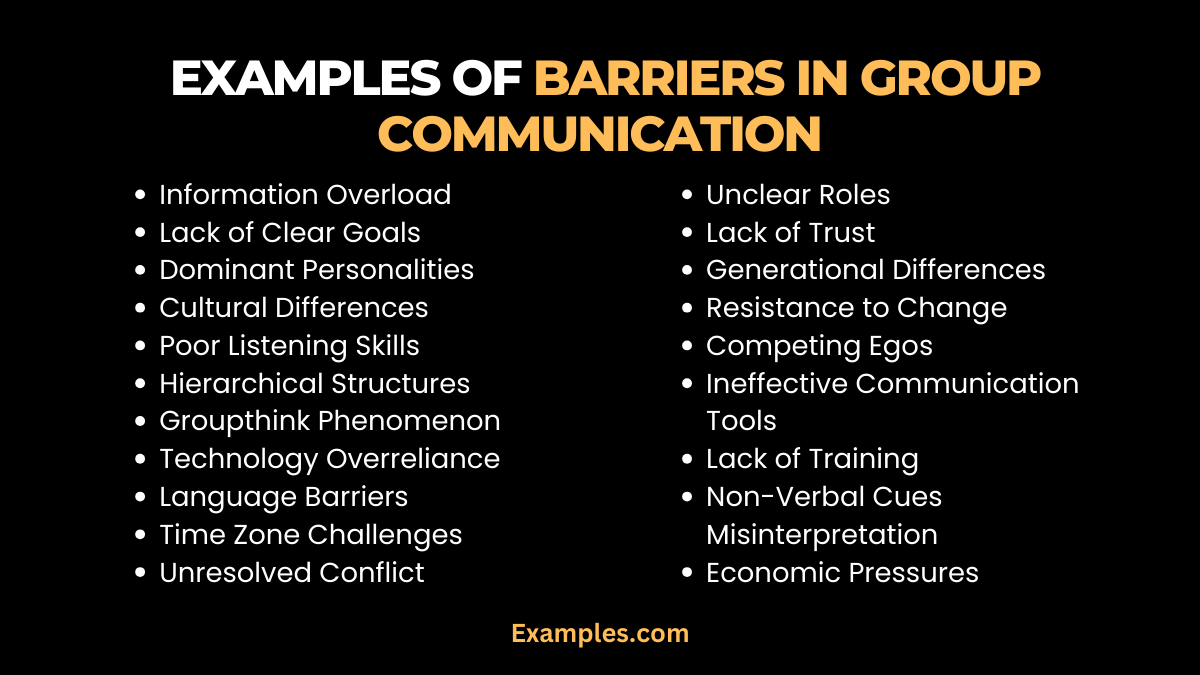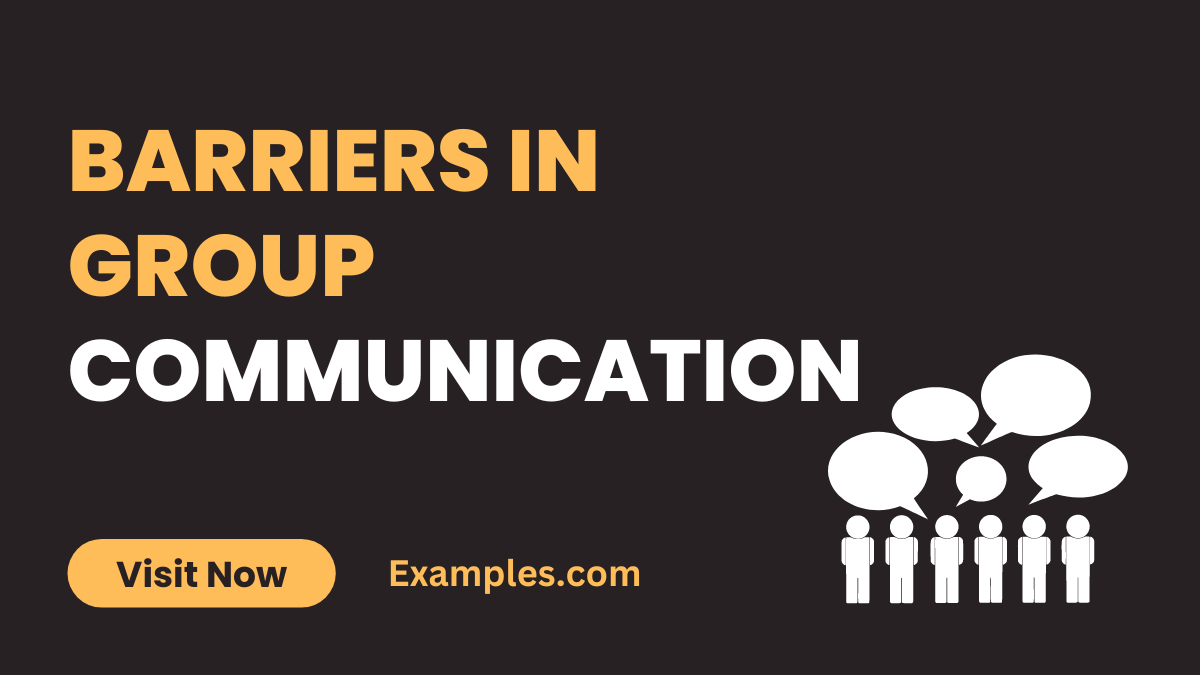19+ Barriers in Group Communication Examples
Group communication is a dynamic yet intricate process often marred by various barriers. In this exploration, we dissect the definition, delve into historical origins, and illuminate examples shaping these hurdles. Understanding the intricacies of group communication barriers is the first step towards fostering a collaborative environment. Dive into the past, grasp the present challenges, and equip yourself with practical tips on overcoming these impediments for more effective and harmonious team interactions.
What is Barriers in Group Communication?

Barriers in group communication refer to the obstacles and challenges that impede the free flow of information within a team or collective setting. These hurdles can manifest in various forms, hindering effective exchange and understanding among group members. Recognizing and understanding these barriers is essential for fostering a conducive environment where communication can thrive, ultimately enhancing teamwork and collaboration.
20 Examples of Barriers in Group Communication

Explore 20 vivid examples of barriers in group communication, shedding light on the challenges that hinder seamless interaction within teams. This comprehensive guide provides valuable insights into recognizing and overcoming these hurdles for more effective collaboration.
- Information Overload: When a team is inundated with excessive data, key messages may get lost. Communicate succinctly to avoid overwhelming your group.
- Lack of Clear Goals: Without defined objectives, communication becomes aimless. Establish clear goals to guide discussions and keep the team focused.
- Dominant Personalities: Overbearing individuals can stifle input from others. Encourage quieter voices and ensure everyone has an opportunity to express their ideas.
- Cultural Differences: Diverse backgrounds may lead to misunderstandings. Foster cultural awareness to promote inclusive communication within the group.
- Poor Listening Skills: Inattentiveness hampers understanding. Cultivate active listening habits to enhance overall group communication effectiveness.
- Hierarchical Structures: Strict hierarchies can discourage open dialogue. Encourage a culture of open communication regardless of organizational rank.
- Groupthink Phenomenon: Blind conformity inhibits creativity. Encourage diverse opinions and foster an environment where dissenting views are valued.
- Technology Overreliance: Relying too heavily on digital communication may lead to misunderstandings. Balance virtual and face-to-face interactions for optimal results.
- Language Barriers: Misinterpretations can arise in multilingual teams. Promote clarity and provide translation assistance when necessary.
- Time Zone Challenges: Global teams face coordination difficulties. Implement flexible scheduling and leverage technology to bridge time zone gaps.
- Unresolved Conflict: Lingering disputes disrupt collaboration. Facilitate conflict resolution sessions to address issues and restore effective communication.
- Unclear Roles: Ambiguity in team roles leads to confusion. Clearly define responsibilities to streamline communication and enhance productivity.
- Lack of Trust: Mistrust stifles openness. Build trust through transparency and reliability to foster a communicative and cohesive group.
- Generational Differences: Differing perspectives across generations can impede understanding. Bridge the gap by acknowledging and respecting diverse viewpoints.
- Resistance to Change: Averse attitudes hinder progress. Communicate the benefits of change to gain team buy-in and ensure a smoother transition.
- Competing Egos: Unchecked egos can escalate tensions. Foster a collaborative environment where collective success takes precedence over individual recognition.
- Ineffective Communication Tools: Outdated or inefficient tools hinder information sharing. Invest in modern communication platforms to streamline group interactions.
- Lack of Training: Inadequate communication skills impact effectiveness. Provide ongoing training to enhance the group’s collective communication proficiency.
- Non-Verbal Cues Misinterpretation: Facial expressions and body language can be misconstrued. Encourage clarity and ask for clarification when needed.
- Economic Pressures: Financial stress may affect communication. Foster an environment where team members feel comfortable discussing financial concerns openly.
Barriers In Group Communication In The Workplace

Effective communication is the cornerstone of workplace success, but various barriers can impede the free flow of information within a group setting. Understanding and addressing these obstacles is paramount for fostering a collaborative work environment. This guide explores the common barriers in group communication at the workplace, providing insights and strategies to enhance communication skills for seamless team interactions.
- Identifying Barriers in Group Communication: Recognizing the diverse obstacles hindering workplace communication is the first step. From hierarchical structures to information overload, understanding these challenges is crucial for improvement.
- Hierarchy and Power Dynamics: Strict organizational hierarchies can stifle open communication. Encouraging a culture where input is valued regardless of position fosters more effective group discussions.
- Cultural and Diversity Challenges: Diverse workplace cultures may lead to misunderstandings. Promoting cultural awareness and inclusivity enhances communication skills within a varied team.
- Technological Barriers: Overreliance on digital tools can result in miscommunications. Striking a balance between virtual and face-to-face interactions is essential for optimal workplace communication.
- Information Overload: The abundance of data can overwhelm teams. Developing concise and focused communication strategies helps prevent information overload.
- Lack of Clear Goals and Direction: Without defined objectives, communication becomes aimless. Establishing clear goals guides discussions and keeps the team aligned.
- Poor Listening Skills: Inattentiveness inhibits understanding. Cultivating active listening habits enhances overall group communication effectiveness.
- Resistance to Change: Averse attitudes towards change hinder progress. Communicating the benefits of change helps gain team buy-in and ensures a smoother transition.
- Role Ambiguity: Unclear responsibilities lead to confusion. Defining roles and responsibilities streamlines communication and enhances workplace productivity.
- Building Trust: Mistrust stifles openness. Building trust through transparency and reliability fosters a communicative and cohesive workplace.
Barriers In Group Communication In Teamwork
Effective teamwork relies on robust communication skills, yet various barriers can impede this critical aspect of collaboration. This comprehensive guide explores the common barriers in group communication within teamwork and provides practical strategies to overcome them, enhancing overall team effectiveness and cohesion.
- Understanding Barriers in Team Communication: Dive into the definition of barriers in group communication specific to teamwork. Uncover the challenges that can hinder effective collaboration among team members.
- The Impact of Barriers on Team Dynamics: Explore how barriers in communication skills can impact the dynamics of a team. Understand the consequences of ineffective communication on productivity, morale, and goal attainment.
- Identifying Common Teamwork Communication Barriers: Delve into the specific obstacles that commonly arise in team settings. Recognize challenges such as poor listening, unclear goals, and cultural differences that may impede seamless communication.
- The Role of Communication Skills in Team Success: Highlight the significance of strong communication skills in fostering teamwork. Showcase how effective communication contributes to a positive team culture and successful collaboration.
- Overcoming Poor Listening Skills in Teams: Address the issue of poor listening within teams. Provide actionable tips on enhancing active listening skills to ensure that team members truly understand and engage with one another.
- Establishing Clear Team Goals: Guide teams in setting and communicating clear objectives. Illustrate how well-defined goals contribute to a shared understanding, reducing ambiguity and enhancing collaboration.
- Fostering Cultural Awareness in Team Communication: Explore the impact of cultural differences on team communication. Provide strategies for fostering cultural awareness to bridge gaps and promote inclusive dialogue.
- Encouraging Open Communication in Team Hierarchies: Discuss the challenges posed by hierarchical structures in teams. Offer tips on encouraging open communication across all levels, promoting a culture of transparency and collaboration.
- Mitigating Groupthink Phenomenon in Teams: Address the dangers of groupthink in teams and how it stifles creativity. Encourage a culture that values diverse opinions and individual contributions.
- Leveraging Technology for Effective Team Communication: Explore the role of technology in overcoming communication barriers. Highlight tools and platforms that facilitate efficient communication within team settings.
What are common group communication barriers?
In the complex landscape of group dynamics, various barriers can impede effective communication. Understanding and addressing these hurdles is crucial for fostering a collaborative and productive team environment. This comprehensive guide explores the common group communication barriers that individuals encounter and provides actionable insights on how to enhance communication skills within a group setting.
- Information Overload: Excessive data can overwhelm group members. Learn to streamline information, focusing on key messages to prevent cognitive overload and ensure clarity.
- Lack of Clear Goals: Ambiguous objectives hinder effective communication. Establish and communicate clear goals to provide a framework for discussions and actions within the group.
- Dominant Personalities: Overbearing individuals can stifle diverse perspectives. Foster an inclusive environment where all group members feel empowered to contribute, regardless of their personality type.
- Cultural Differences: Diverse backgrounds may lead to misunderstandings. Cultivate cultural awareness within the group to promote inclusive and respectful communication.
- Poor Listening Skills: Inattentiveness hampers understanding. Develop active listening skills within the group to enhance overall communication effectiveness.
- Hierarchical Structures: Strict hierarchies can discourage open dialogue. Encourage a culture of open communication, irrespective of organizational rank, to facilitate free exchange of ideas.
- Groupthink Phenomenon: Blind conformity inhibits creativity. Encourage diverse opinions and foster an environment where dissenting views are valued for more robust decision-making.
- Technology Overreliance: Excessive reliance on digital communication tools may lead to misunderstandings. Find a balance between virtual and face-to-face interactions to optimize communication channels.
- Language Barriers: Misinterpretations can arise in multilingual teams. Promote clarity and provide translation assistance when necessary to bridge language gaps.
- Time Zone Challenges: Global teams face coordination difficulties. Implement flexible scheduling and leverage technology to bridge time zone gaps for more efficient communication.
What Are Five Barriers To Effective Communications In The Workplace?
Effective workplace communication is pivotal for organizational success, yet numerous barriers can impede its seamless flow. Understanding and overcoming these hurdles is crucial for cultivating robust communication skills within the workplace. This comprehensive guide explores five common barriers, providing actionable insights on how to dismantle these obstacles and enhance communication proficiency among team members.
- Physical Barriers: Physical obstacles, such as cubicle layouts or closed office doors, hinder spontaneous communication. This section outlines strategies to overcome these physical barriers, fostering an environment conducive to open and accessible dialogue.
- Semantic Barriers: Misunderstandings arising from language nuances and interpretation differences can impede communication. Learn techniques to enhance semantic clarity, ensuring that messages are conveyed accurately and comprehensively.
- Cultural Barriers: Diverse workplace cultures can lead to misinterpretations and communication breakdowns. Explore cultural sensitivity training and strategies to bridge gaps, promoting effective communication across diverse teams.
- Technological Barriers: Overreliance on technology can result in communication gaps, especially in virtual workspaces. This section provides insights into leveraging technology effectively and mitigating potential challenges for seamless digital communication.
- Psychological Barriers: Individual psychological factors, such as stress or resistance to change, can impact communication effectiveness. Discover strategies to address and alleviate psychological barriers, fostering a conducive mental environment for clear and collaborative communication.
How To Overcome The Four Most Common Teamwork Barriers?
Effective communication skills form the bedrock of successful teamwork. In this guide, we delve into overcoming the four most prevalent barriers that impede collaborative efforts. Equip yourself with actionable strategies to enhance communication skills, foster a harmonious team environment, and ensure collective success in the face of common hurdles.
- Identifying the Four Common Teamwork Barriers: Begin by recognizing and understanding the specific barriers hindering teamwork. Pinpoint common challenges such as poor communication, lack of trust, divergent goals, and conflicting personalities.
- Cultivating Clear Communication Skills: Elevate team communication by emphasizing clarity, active listening, and effective expression. Develop a shared language within the team, ensuring that everyone comprehends and contributes to discussions meaningfully.
- Building Trust Through Transparent Communication: Trust is the cornerstone of successful teamwork. Explore techniques to build and maintain trust through transparent communication. Address concerns openly, acknowledge achievements, and foster an environment where team members feel secure in sharing their thoughts.
- Aligning Team Goals for Unified Direction: Overcome divergent goals by aligning team objectives. Facilitate discussions to establish a unified vision and ensure that every team member understands their role in achieving collective success. Clearly define roles and responsibilities to minimize confusion.



